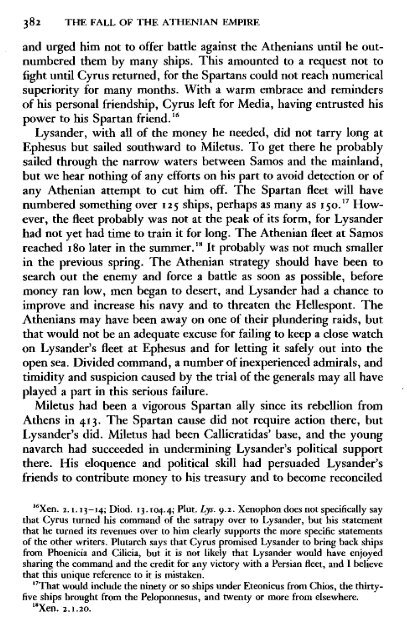The Fall of the Athenian Empire-(A New History of the Peloponnesian War) Donald Kagan - (1987)
MACEDONIA is GREECE and will always be GREECE- (if they are desperate to steal a name, Monkeydonkeys suits them just fine) ΚΑΤΩ Η ΣΥΓΚΥΒΕΡΝΗΣΗ ΤΩΝ ΠΡΟΔΟΤΩΝ!!! Strabo – “Geography” “There remain of Europe, first, Macedonia and the parts of Thrace that are contiguous to it and extend as far as Byzantium; secondly, Greece; and thirdly, the islands that are close by. Macedonia, of course, is a part of Greece, yet now, since I am following the nature and shape of the places geographically, I have decided to classify it apart from the rest of Greece and to join it with that part of Thrace which borders on it and extends as far as the mouth of the Euxine and the Propontis. Then, a little further on, Strabo mentions Cypsela and the Hebrus River, and also describes a sort of parallelogram in which the whole of Macedonia lies.” (Strab. 7.fragments.9) ΚΚΕ, ΚΝΕ, ΟΝΝΕΔ, ΑΓΟΡΑ,ΕΚΚΛΗΣΙΑ,ΝΕΑ,ΦΩΝΗ,ΦΕΚ,ΝΟΜΟΣ,LIFO,MACEDONIA, ALEXANDER, GREECE,IKEA
MACEDONIA is GREECE and will always be GREECE- (if they are desperate to steal a name, Monkeydonkeys suits them just fine)
ΚΑΤΩ Η ΣΥΓΚΥΒΕΡΝΗΣΗ ΤΩΝ ΠΡΟΔΟΤΩΝ!!!
Strabo – “Geography”
“There remain of Europe, first, Macedonia and the parts of Thrace that are contiguous to it and extend as far as Byzantium; secondly, Greece; and thirdly, the islands that are close by. Macedonia, of course, is a part of Greece, yet now, since I am following the nature and shape of the places geographically, I have decided to classify it apart from the rest of Greece and to join it with that part of Thrace which borders on it and extends as far as the mouth of the Euxine and the Propontis. Then, a little further on, Strabo mentions Cypsela and the Hebrus River, and also describes a sort of parallelogram in which the whole of Macedonia lies.”
(Strab. 7.fragments.9)
ΚΚΕ, ΚΝΕ, ΟΝΝΕΔ, ΑΓΟΡΑ,ΕΚΚΛΗΣΙΑ,ΝΕΑ,ΦΩΝΗ,ΦΕΚ,ΝΟΜΟΣ,LIFO,MACEDONIA, ALEXANDER, GREECE,IKEA
You also want an ePaper? Increase the reach of your titles
YUMPU automatically turns print PDFs into web optimized ePapers that Google loves.
386 THE FALL OF THE ATHENIAN EMPIRE<br />
stroying his fleet, and driving him from <strong>the</strong> straits. <strong>The</strong> A<strong>the</strong>nians<br />
appear to have pursued Lysander by way <strong>of</strong> Chios." But <strong>the</strong>y were<br />
at least a day or two behind, for <strong>the</strong>y were only at Elaeus, at <strong>the</strong> mouth<br />
<strong>of</strong> <strong>the</strong> Hellespont, when <strong>the</strong>y heard <strong>of</strong> <strong>the</strong> fall <strong>of</strong> Lampsacus. <strong>The</strong>y<br />
hurried to <strong>the</strong>ir base at Sestos and <strong>the</strong>n made camp at Aegospotami,<br />
on <strong>the</strong> beach just across <strong>the</strong> Hellespont, about three miles away (see<br />
Map q)." A key to understanding <strong>the</strong> course <strong>of</strong> events is that Aegospotami<br />
was only a beach, a place without a proper harbor, a little<br />
to <strong>the</strong> east <strong>of</strong> <strong>the</strong> modern Turkish town called Siitliice, or Galata in<br />
its Greek form, <strong>the</strong> ancient town <strong>of</strong> Aegospotami." <strong>The</strong> A<strong>the</strong>nian fleet<br />
consisted <strong>of</strong> 180 ships." This included about 36,ooo men, so <strong>the</strong> small<br />
town <strong>of</strong> Aegospotami was unable to supply <strong>the</strong> food, water, and o<strong>the</strong>r<br />
things that so vast a force required.<br />
<strong>The</strong> nearest place to get adequate supplies was Sestos, about twelve<br />
miles away, so <strong>the</strong> A<strong>the</strong>nians would <strong>of</strong>ten need to divide <strong>the</strong>ir forces<br />
to obtain supplies, and <strong>the</strong> men would <strong>of</strong>ten be scattered in search <strong>of</strong><br />
food and water. Why did <strong>the</strong>y establish <strong>the</strong>ir base in so inconvenient<br />
a location? <strong>The</strong> answer lies in strategic requirements that seemed to<br />
outweigh logistical difficulties. <strong>The</strong> A<strong>the</strong>nians were eager to engage<br />
<strong>the</strong> enemy in a great battle as soon as possible, before <strong>the</strong>ir own money<br />
11<br />
Xen. :z.I.I8.<br />
HXen. 2.1.20-21. For <strong>the</strong> location <strong>of</strong> Aegospotami, see Bommelaer, Lysandre, III<br />
II]; and map at end. <strong>The</strong> ancient sources for <strong>the</strong> battle <strong>of</strong> Aegospotami are Xen.<br />
z.I.:zz-Jo;Diod. I]. IOS-6;Plut. Lys. Io-I 1 and A/c. 36-J7;Frontinus 2.1. 18;Polyaenus<br />
1.45·2; Paus. 9·J2·9i and Nepos, Ale. 8. <strong>The</strong> most helpful modern accounts are: D.<br />
Lotze, Lysander und der Peloponnesische Krieg (Berlin, 1965), 32-J7; C. Ehrhart, Phoenix<br />
XXIV (1970), 225-228; B. S. Strauss, AJP CIV (I98J), 24-35; and Bommelaer, Lysandre,<br />
IOI-115.<br />
15<br />
Piut. Ale. 36.5. For <strong>the</strong> location <strong>of</strong> <strong>the</strong> A<strong>the</strong>nian base and <strong>the</strong> town <strong>of</strong> Aegospotami,<br />
see Strabo 7·33 I, fr. 55· Bommelaer(Lysandre, IT I-113) has a useful discussion, placing<br />
<strong>the</strong> site to <strong>the</strong> east <strong>of</strong> <strong>the</strong> modern Turkish town <strong>of</strong> Siidiice, at <strong>the</strong> mouth <strong>of</strong> <strong>the</strong> stream<br />
called Biiyiik Dere, located just south <strong>of</strong> <strong>the</strong> point, <strong>the</strong> Si.itliice Burnu (see Map I 3).<br />
B. S. Strauss, in a forthcoming article ("A Note on <strong>the</strong> Topography and Tactics <strong>of</strong><br />
<strong>the</strong> Battle <strong>of</strong> Aegospotami" to be published in AJP), which he has been kind enough<br />
to show me, points out <strong>the</strong> advantages <strong>of</strong> such a location: "It has two streams (hence<br />
potamr), a beach for triremes, and it is indeed directly opposite Lampsacus." In addition,<br />
a site far<strong>the</strong>r to thC southwest would require <strong>the</strong> A<strong>the</strong>nians rowing to Lampsacus to<br />
fight a strong current and an unfavorable wind. "<strong>The</strong> wind is a strong nor<strong>the</strong>asterly;<br />
<strong>the</strong> surface current flows southward at an average rate <strong>of</strong> about I knot along <strong>the</strong> coast<br />
... and even faster in <strong>the</strong> center <strong>of</strong> <strong>the</strong> straits." <strong>The</strong>se facts, coupled with <strong>the</strong> greater<br />
distance between Lampsacus and any o<strong>the</strong>r suggested site, make it clear that an A<strong>the</strong>nian<br />
fleet sailing up <strong>the</strong> strait from any o<strong>the</strong>r site would have run <strong>the</strong> risk <strong>of</strong> exhausting<br />
itself by <strong>the</strong> time it came to grips with <strong>the</strong> enemy.<br />
J 6 0iod. IJ.I05.I.

















